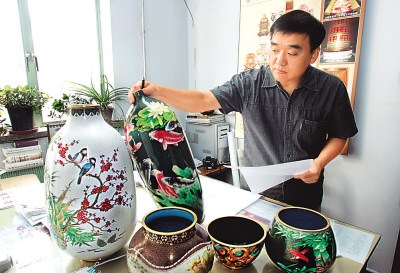(Ecns.cn)--Though it did not originate in China, the craft of cloisonné enamel for decorating and coloring metal is widely accepted by the international community as one of the country's most developed and refined artisanal forms.
Enameling technology entered the Forbidden City during the Yuan dynasty (from 1271 to 1368) with Chinese designs that pleased royal families and earned it the beautiful name of "Blue Jing-Tai."
After 600 years of development, in 2006 Chinese style enameling was among 518 items on the first list of national intangible cultural heritages.
Since the founding of the People's Republic of China in 1949, there have been altogether six national inheritors of the enamelware art. Among them is Zhong Liansheng, 49, a notable figure who is renowned as a leader in the industry.
Starting from scratch
As a boy Zhong showed an affinity for painting, and after graduating from junior middle school in 1978 he chose to attend a technical school established by the time-honored Beijing Enamel Factory.
That turned out to be a life-changing decision. "At the time, schools for painting were rare, so the reason I finally picked the technical school was very simple: I could learn to paint there," recalled Zhong.
Zhong had never heard of enameling and none of his family had ever worked in the field. But after three years of study, in addition to learning techniques of traditional and foreign painting, Zhong had also grasped the knowledge of designing and making traditional enamelware.
"As students, we had pretty good theoretical knowledge, but it didn't mean we could make perfect enamelware," said Zhong. "Our performance in the factory later proved that we needed more practice."
After graduating from the technical school, Zhong was assigned to work in the Beijing Enamel Factory. Although some of his peers thought it was a waste of time to work there, Zhong said he learned a precious lesson from the experience.
Making an enamel vase requires a very complicated process involving 100 or more procedures, all of which have to be done by hand. "Sometimes, it takes hours just to paste a tiny copper wire to the surface of a vase," said Zhong.
The work of making enamel vases equipped him with valuable practical experience which later guided his further study.
In 1984, Zhong went to college to study decorative painting. By the time he graduated, the development of enameling had entered a period of decline, and Zhong was forced to go back to the technical school and become a teacher, and later a technician in the factory.
There, Zhong began finding new inspiration for the traditional art form, and developed his own way of designing enamelware.


















